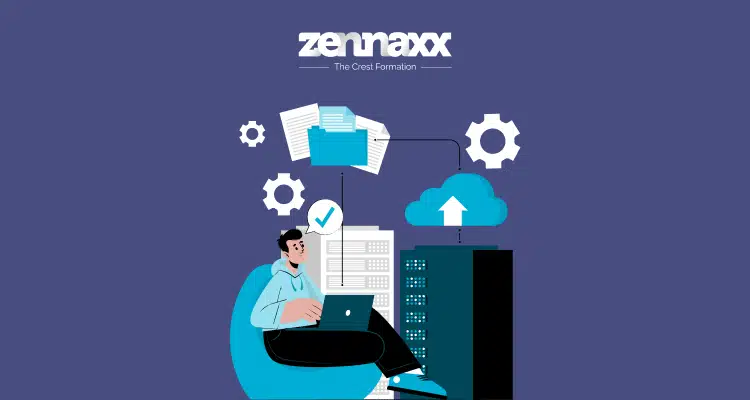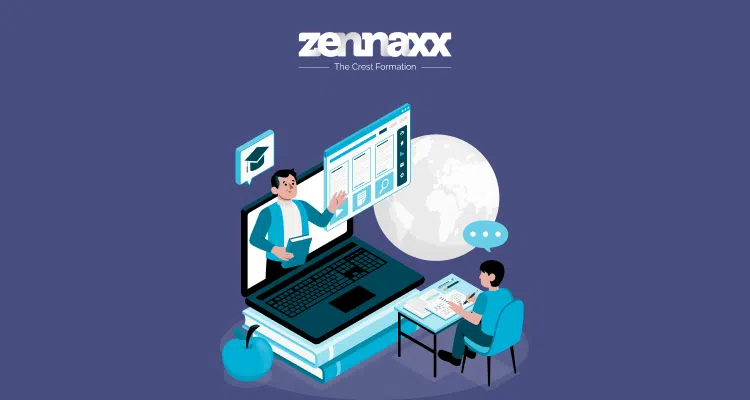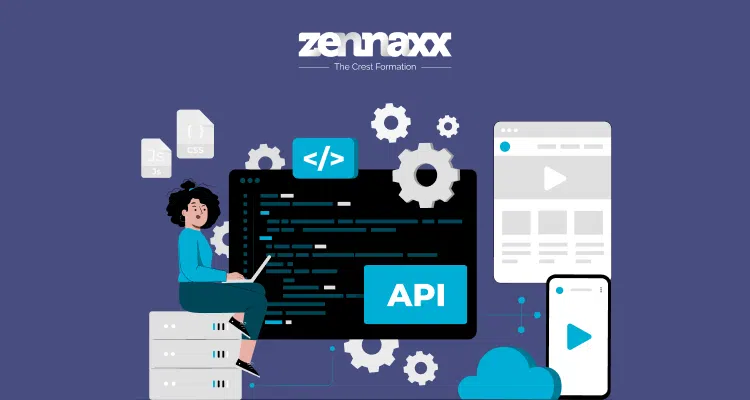Businesses are prioritizing cloud computing these days. During the COVID pandemic, it became lifesaving, sustaining worldwide supply chains.
It changes remote working and assists in maintaining the economy. Businesses now realize its benefits in cost savings, increased flexibility, scalability, and business growth.
Migrating to the cloud can open many options for connecting to other parts of the world.
However, there are stability, cost, and, most importantly, security concerns.
For many people, a successful cloud migration reduces cost, improves scalability, and significantly reduces the risk of a cyber incident that could derail their business.
A cloud migration strategy is an organisation’s high-level plan to move existing on-premises and co-located application workloads and their associated data into the cloud.
As an on-demand, self-service environment, the cloud is vital to achieving end-to-end digital transformation and to helping businesses reopen, reinvent, and overcome uncertainty.

What are the types of cloud migration strategies?
Here are the six common types of cloud migration strategies that organizations can consider when planning their move to the cloud.
They know it as the six Rs: rehost, re-platform, repurchase, retain, retire, and refactor.
Each type has a unique strategy for transferring data and applications.
With this detailed information, you can make the right decisions about migrating to the cloud.
Rehosting (“lift and shift”)
Rehosting means moving your current environment from on-premises hosting to the cloud while keeping most of the configuration unchanged.
It’s a quick way to achieve ROI as you move an exact copy of your stack to the cloud. This approach is appropriate for companies with a conservative culture or that lack a long-term cloud strategy.
Replatforming
Replatforming is similar to rehosting in that it depends on making changes to optimize your landscape for the cloud.
The core architecture remains unchanged, but minor changes are made to improve performance.
Replatforming is ideal for conservative organizations that want to build trust in the cloud while improving system performance.
Repurchasing
Repurchasing means moving applications to a new, cloud-native product, typically a SaaS platform such as Salesforce.
This could mean getting less familiar with the current code, but it can be economical, mainly if you come from a highly customized legacy environment.
Refactoring
Refactoring, or rearchitecting, is rebuilding applications from scratch to take advantage of cloud capabilities that are not currently available.
This is triggered by the demand for cloud auto-scaling and serverless computing features. Refactoring is the most expensive option but aligns well with future cloud versions.
Retiring
After you evaluate your application portfolio for cloud readiness, some applications may become obsolete.
Turning them off can result in significant savings, potentially strengthening the business case for other migration-ready applications.
Retaining
Cloud adoption may not be feasible in certain situations. Compliance requirements or a lack of readiness for specific applications may cause migration delays.
Organizations can revisit cloud computing later and prioritize migration based on business needs.
Each type of migration has its own set of benefits and challenges. Knowing your organization’s needs and objectives can help you select the best cloud migration strategy.
Connect to the best cloud migration strategy consulting to better understand.

5 Phases of Cloud Transformation
The cloud transformation process is commonly divided into five stages: prepare, plan, migrate, operate, and optimize. These phases provide a complete system for migrating workloads and data to the cloud, reducing disruption while increasing benefits.
Prepare
Before launching a cloud migration, you must clearly define your business objectives. These goals range from increased agility and cost savings to improved performance and scalability.
An initial assessment of the current IT infrastructure makes it easier to understand the resources available and what needs to be migrated.
Building a complete business case for each application to be migrated is also essential, outlining the expected total cost of ownership in the cloud versus the current setup.
Cloud cost calculators can help you predict future costs by incorporating storage, computing resources, instance types, operating systems, and specific performance and networking needs.
Plan
Once your business objectives are set and the capacity for cloud migration is evaluated, you can create a detailed migration plan.
This plan should include a roadmap indicating which workloads will be migrated and in what order.
This phase should also include decisions about the preferred cloud architecture and any necessary changes to existing applications or data.
It is also essential that you meet migration-related compliance and security requirements.
Evaluating the environment and determining migration factors, such as compliance requirements and important application data, can help identify the data that needs to be migrated and the migration strategy that should be used.
Migrate
Data, applications, and workloads are moved to the cloud during the migration phase.
Several ways exist, such as rebuilding, refactoring, or lift-and-shift applications.
Data migration is a necessary process that must be carefully managed to avoid disruptions to business operations.
Before moving on to migrating other workload elements, each one should be tested to ensure it works in the new environment.
It is also essential to synchronize changes to the source data during the migration process.
Operate
You can enter the operating phase once workloads are successfully migrated to the cloud.
This involves managing workloads in the cloud environment, monitoring performance, managing resources, and maintaining security and compliance.
Real-time monitoring contributes to data security and regulatory compliance. You should focus on meeting performance and availability benchmarks to achieve their goals.
Discover the power of our Cloud Migration Services
Embrace efficiency, scalability, and innovation. Let’s take your business to new heights.
Optimize
The final phase focuses on optimizing the performance and efficiency of the cloud environment.
This includes optimizing cloud operations, identifying cost-cutting opportunities, and using cloud-native features or services to improve performance.
Continuous optimization is essential, as you can strive to improve cloud operations and increase business value over time.
Understand the critical stages of cloud migration to reduce risks and disruptions and maximize the return on investment.
These steps can help you transition smoothly to the cloud and achieve your desired business outcomes.
What are the benefits of migrating to the cloud?
Businesses can benefit from cloud migration by saving money, increasing flexibility, and improving scalability.
It helps access data and applications from anywhere with an internet connection, promoting collaboration and remote work capabilities.
Let’s understand the benefits of cloud migration.
Improved Security
Cloud migration gives powerful security features that often beat traditional network systems.
The “shared responsibility” concept used in cloud settings ensures data privacy and security.
Cloud platforms such as Amazon have prioritized security from the start, giving users confidence in the safety of their data.
Scalability
You can quickly scale your resources up or down in response to fluctuating IT demands and organizational needs.
Cloud services provide flexible adjustments and give businesses efficient chances to change market conditions, unlike traditional solutions that require long-term contracts and fixed infrastructure.
Scalability improves your resources and reduces your organization’s costs by removing the need for excessive infrastructure maintenance.
Cost Efficiency
Cloud migration also reduces costs by eliminating the expenses of maintaining on-premises data centres.
You can optimize your IT budgets and allocate resources more efficiently by using pay-as-you-go models and reducing overhead costs.
Studies have shown that migrating to the cloud can result in significant savings on operational expenses, energy costs, and IT maintenance, allowing organizations to reinvest those funds in core business activities and innovation initiatives.
Smooth Integration
Cloud migration helps with the easy integration of systems and services. It increases overall operational efficiency and productivity.
Moving to the cloud can provide several benefits, such as smooth processes, shared systems, and improved teamwork.
Cloud environments facilitate automatic updates and infrastructure maintenance, reducing the burden on IT staff and performance.
Accessibility
Your employees can now work from anywhere, anytime, and on any device, providing universal access to data and apps.
This accessibility removes geographical limits and enables remote collaboration, flexibility, and productivity.
Cloud services also provide monitoring, backup, and logging capabilities for every member’s data availability and facilitate disaster recovery efforts.
Decreased Footprint
Cloud migration helps to support environmental sustainability by improving resource utilization and lowering energy consumption.
Unlike traditional on-premises data centres that require constant energy consumption, cloud environments dynamically scale server capacity based on demand.
This consolidation reduces IT operations’ overall environmental footprint, mitigating their impact on the planet and aligning with corporate sustainability objectives.
Furthermore, cloud providers frequently invest in renewable energy sources and energy-efficient technologies, which reduces the environmental impact of cloud computing.
Ready to extend your business with cloud migration?
Discover effortless cloud migration with our services. Say hello to efficiency, scalability, and innovation. Let’s extend your business together.
What are the challenges of cloud migration?
Migrating to the cloud provides multiple advantages in technology, but it also brings some challenges. Here are some of the key challenges you may face during the cloud migration process:
Downtime
Transitioning from in-house servers to the cloud may cause temporary server outages.
However, if not handled properly, these outages can significantly impact application performance.
You can minimize downtime through meticulous planning, backup systems, and efficient resource allocation.
Data loss
Data is especially vulnerable to loss or compromise during the migration process.
To protect sensitive data and reduce the risk of a breach, you must implement strong cloud security measures such as privileged access management and application encryption.
Resource management
IT professionals used to managing physical servers may find it challenging to transition to the cloud.
You may need to educate your employees on the new infrastructure or introduce new IT management roles.
You may also need to restructure their operations to manage cloud resources more effectively.
Interoperability
Integrating existing applications into cloud environments can take time and effort.
Processes may need to be adjusted to meet the standards of the cloud provider to ensure seamless communication between legacy systems and the cloud.
Interoperability issues can impede a smooth transition to the cloud and disrupt business operations.
Lack of Strategy
Without a well-defined migration strategy, you might encounter various issues throughout the migration process.
For the cloud transition to succeed, a thorough plan must handle issues like risk management, application compatibility, and data migration.
Cost Management
Cloud migration may create unnecessary expenses if you are not carefully managing it.
To avoid budget overruns, you must accurately estimate the data transfer, storage, and usage costs.
Implementing cost-cutting tools and strategies can assist you in optimizing cloud spending and maximizing returns.
Vendor Lock-In
Depending on a single cloud provider can limit flexibility and scalability. To reduce the risk of vendor lock-in, companies should use a multi-cloud or hybrid cloud strategy.
This gives you more service options and keeps you from relying on just one provider.
Data Security and Compliance
Data security and compliance standards must be maintained during the cloud migration process.
You must ensure that cloud environments meet regulatory requirements and have robust security measures to protect sensitive data.
Challenges also come with new technological steps; you must first be aware of them for solutions. This awareness of the challenges will now help to find solutions.

Migrating Data to the Cloud with NetApp Cloud Volumes ONTAP
Migrating data to the cloud can be complicated, require multiple steps, and sometimes create many challenges.
One of the most challenging aspects, particularly in large enterprises, is the transfer and synchronization of significant data volumes. This raises many issues, sometimes without a proper solution.
NetApp’s cloud solutions aim to make migration easier by providing tools for fast, secure data movement and synchronization.
This solution will cover your most common issues and ensure a smooth migration. Let’s learn about the great benefits of using NetApp’s cloud solutions for data migration.
Faster Transfers, Lower Costs
Via Cloud Volumes ONTAP, NetApp provides a wide range of tools to speed up data synchronization, automate procedures, and guarantee data security throughout cloud migrations.
Thanks to NetApp’s SnapMirror data replication technology integrated into Cloud Volumes ONTAP, you can quickly move workloads and data to the cloud, adhering to pre-established schedules and maintaining continuous synchronization even after the initial migration phase.
Cloud Volumes ONTAP’s storage efficiencies help to reduce network bandwidth costs during migrations by shrinking storage footprints and speeding up data transfers.
SnapMirror allows users to use FAS or AFF ONTAP storage systems to move data quickly between the cloud and on-premises environments.
NetApp provides cloud sync for migrations involving non-ONTAP systems.
High Availability with Cloud Volumes ONTAP
One of the most critical metrics for measuring uptime is the ability to anticipate and mitigate potential challenges to business continuity during cloud migration.
Availability Zone problems, drive malfunctions, and incorrect network configurations are some of these difficulties.
NetApp’s Cloud Volumes HA configuration addresses these concerns by having a recovery point objective (RPO) of zero and a recovery time objective (RTO) of less than 60 seconds.
A dual-node infrastructure that writes changes to both nodes simultaneously during storage operations enables this level of resilience.
As a result, in the event of a node failure, operations seamlessly transition to the remaining node, ensuring uninterrupted service from both the application and end-user perspectives.
These features improve your cloud environment’s resilience and protect it from service disruptions.
They allow you to support critical workloads and data migration processes without needing expensive, high-availability setups on the application side.
It’s worth noting that this service provides customized configurations for each cloud provider.
Refer to the links below for more information on high-availability AWS, Azure, or Google Cloud configurations.
Data Protection
Cloud Volumes ONTAP uses NetApp Snapshot technology to create application-aware snapshots without performance impact and with minimal storage space.
These snapshots can be created in a matter of seconds, regardless of the size of the volume being copied.
Unlike traditional methods that involve copying all data in the system, NetApp Snapshots only replicate modified data by manipulating block pointers.
Cloud Volumes ONTAP’s application-aware snapshots provide an economical and highly effective solution that ensures system protection with little overhead for ongoing migrations.
Additionally, users can streamline backup procedures by having the snapshot creation process fully automated.
This method frequently offers advantages over using native disk backup services from Google Cloud, AWS, or Azure.
Data Classification
Understanding the scope and location of data movement is more critical during migration operations.
NetApp’s BlueXP classification tool is a robust data governance and classification solution capable of automatically discovering, mapping, classifying, and managing enterprise data regardless of where it is stored—on-premises or in the cloud.
Through BlueXP classification, users gain comprehensive visibility and control over data, which is made possible by automated processes, AI-driven metadata, and data context analysis.
For businesses starting on migration initiatives, these functionalities are invaluable in identifying the location of sensitive data and enabling appropriate measures to safeguard it by privacy laws.
The tool also helps identify duplicate and obsolete data, streamlining the migration process by allowing for clean data transfers.
Cost Optimization
Cloud Volumes ONTAP provides significant benefits through a suite of storage efficiency features, including thin provisioning, data compression, duplication, compaction, data tiering, and FlexClone writable clones.
These features work seamlessly together to reduce storage consumption and data transfer costs.
Companies that implement these efficiency measures can realize significant cost savings, ranging from 50% to 70% on storage and data transfer expenses.
Want to Automate Your Business Process With a Software Solution?
Zennaxx, a leading software development firm in Canada, has delivered 700+ bespoke solutions spanning various industries.
Proven Success with Cloud Volumes ONTAP
Numerous businesses have used Cloud Volumes ONTAP to simplify workload migrations and achieve significant storage efficiency gains, resulting in considerable cost savings.
Here are some of the satisfied customers:
AWS
Monash University, Australia’s largest university, successfully implemented an AWS cloud migration strategy utilizing Cloud Volumes ONTAP.
The university used Cloud Volumes ONTAP for AWS to efficiently decommission its data centres and seamlessly migrate its extensive student data and educational software repository to AWS storage.
Monash had to ensure that student, business, and research activities were maintained throughout the migration process.
According to Monash’s infrastructure leader, Cloud Volumes ONTAP was critical in enabling a seamless transition to the cloud.
Cloud Volumes ONTAP enabled Monash University to quickly and confidently navigate its cloud migration journey by seamlessly migrating data and extending the benefits of its onsite NetApp data management and data protection to AWS.
Azure
A global clothing retailer headquartered in San Francisco, with five distinct clothing brands and 3,300 locations in over 90 countries, found success with Cloud Volumes ONTAP.
The retailer was forced to adopt a cloud migration strategy to strengthen its brands’ online presence, but managing enormous amounts of image and video data in the cloud and effectively executing the migration process presented a challenge.
With the flexibility required to support their Azure migration strategy, Cloud Volumes ONTAP for Azure was the answer.
The retailer could store and manage their extensive collection of multimedia assets efficiently and move their operations to the cloud as a result.
Google Cloud
A Fortune-500 ranked global healthcare services and products company headquartered in the UK, with 50,000 employees catering to hospitals, pharmacies, physicians, labs, and health systems worldwide, successfully utilized Cloud Volumes ONTAP to streamline their Google Cloud migration.
The company’s transition to Google Cloud was a strategic move towards embracing a cloud-first approach, aiming to migrate all legacy systems to the public cloud.
The migration project required a reliable platform to move data between the cloud and the company’s on-site data centres without interruption.
It was also crucial for the platform to enable a smooth multi-cloud experience because data migration involved both Google Cloud and AWS.
The company chose it as their migration platform because Cloud Volumes ONTAP can transfer data to Google Cloud and maintain user-friendliness in multi-cloud environments.
With features like multiprotocol file sharing and persistent data storage for Kubernetes clusters, Cloud Volumes ONTAP enabled data to be managed successfully across multiple cloud platforms.
Conclusion
Now, it’s clear what the cloud migration strategy is. Every business is accepting a new working method and switching to cloud migration.
A successful cloud migration strategy will make your business more stable and flexible. The future of technology is highly dependent on cloud migration.
This blog provides enough information about cloud migration to clarify the concept of planning cloud migration.
Contact us for a more detailed discussion on how to do cloud migration and how the complexities of cloud migration affect your business.
Zennaxx software solutions can provide expert guidance and support for a smooth switch to cloud migration.









